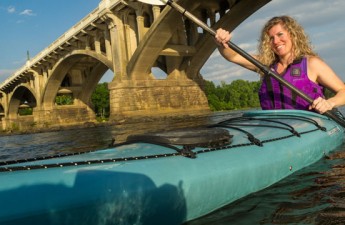
Thank you for tuning into our webinar on Revitalizing Communities through Recreation and River Protection! We appreciated all of your comments and feedback and questions. Below you will find all of the questions that were asked during the webinar. Do you have additional questions? Ask us here!
How long is Hitchcock Creek?
Hitchcock Creek Blue Trail is 14 miles long. The Creek itself is about 25 miles long. Hitchcock Creek along with several tributaries drain a watershed of approximately 62 square miles.
Who completed the work of removing debris after taking out Steeles Mill Dam?
After removing Steeles Mill Dam, city employees were tasked were removing the debris.
If there aren’t already adequate buffer ordinances describe some actions we might take to rectify that situation.
In this situation, I would suggest working with your local county and city officials to help develop a strong buffer ordinance. Building a campaign to help develop support for this initiative is also important – stating what benefits will come from have a strong ordinance and why the municipality, in addition to the residents and local business will benefits from this new ordinance.
Is there a local friends group established for supporting the trail. If so, how did it get started.
No there is currently not a designated friends group for Hitchcock Creek. The development of the Blue Trail and the great work the city of Rockingham and their partners did to develop the Blue Trail has created a group of local stewards that organize cleanups, paddles and other activities to continue building support. The city of Rockingham is in charge of managing and maintaining the trail and the hiking paths alongside it.
Was there a master plan document developed?
Yes, there was a watershed plan that was developed that had a recreation component included. Once the city recognized the great potential by engaging the community with recreation after the dam was removed, there was a larger push and effort to develop the greenway and the Blue Trail.
Which organization provided the grant for fish counts?
American Rivers received a grant through the NOAA Coastal Services Center to conduct pre- and post- dam removal monitoring of the fish community and freshwater mussels, as well as changes in stream channel geomorphology.
Was the Steeles Mill Dam a FERC reviewed project? If so, please talk briefly about that process.
Yes. Steeles Mill Dam had been licensed by the Federal Energy Regulatory Commission. The mill owner voluntarily surrendered the license prior to dam removal.
Do you have examples of the landowner agreements (if there are any in place) for the new access?
Points of access were provided at publicly owned lands and right of ways. Landowner agreements were to protect and conserve land along the Blue Trail.
Who coordinated the watershed planning and greenway planning?
The city of Rockingham coordinated the planning of the greenway and the Blue Trail.
What was helpful information to tell landowners that were potentially interested in conservation easements? Did you have to do a lot of individual outreach or were people already interested in protecting their land?
Due to the positive publicity surrounding the development of the Blue Trail, landowners along Hitchcock Creek were incredibly interested in putting their land into conservation easements without much individual outreach. We credit this interest to the positive association people had with the Blue Trail and the great benefits that the Blue Trail had for the local community. Local land trusts can provide excellent information on the benefits of land conservation and how to communicate that with landowners. Here is a related link from the Land Trust for Central North Carolina. http://landtrustcnc.org/land-owners/
Can you give an example of overcoming landowner/riparian objections?
We did not experience much push back from landowners around the Blue Trail development. I would recommend in this situation listening to the landowners concerns and trying to identify with them what will make them feel better – what benefits can we describe to them, what concerns can we help to alleviate. How can we find a compromise so that the users can still enjoy the Blue Trail while the landowner understands that the users and managers respect their property.
What information was most helpful to landowners when they were considering providing access?
Most of the landowners came forward interested in providing a conservation easement on their land. I would say the biggest contribution to successful conservation easements was talking about the benefits it had for the landowner as well as the local community and visitors to the Blue Trail and greenway. People responded really well to positive incentives.
